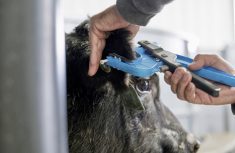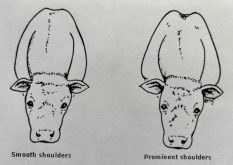Sandy Russell is skilled at seeing possibilities and turning them into profit.
Her career thus far has allowed her to assist different facets of the Canadian beef industry in finding greater value. Now she’s poised to lead a major initiative to capitalize on untapped opportunities to capture value from genetic data across the entire beef production chain.
“We all know that the beef cattle business is a difficult business. Generating profit and securing long-term value for your product, whatever segment you’re involved in, is a challenge,” says Russell, who was recently named the new CEO of the Canadian Beef Breeds Council.
Read Also

Canadian Beef Check-Off Agency reports on investments and activities
The check-off agency’s work behind the scenes is what ensures cattle check-off dollars are invested wisely, accounted for transparently and deliver measurable value back to producers and importers.
“But I fundamentally also believe that if we hone our business skills and really put some attention on various data decision-making processes, you can capture more value for your product,” she continues.
“So I have always been very focused on trying to help producers and help the industry secure more profit and secure more value out of the end product of what we’re producing, and create that sustainability that we’ve all been working on for so long within your individual operation but also the industry as a whole.”
This focus has been present since the start of her career. Russell, who was raised on a commercial cow-calf operation at Outlook, Sask., where she’s based today, studied agriculture at the University of Saskatchewan. After earning a bachelor of science and master of science, she began working as Saskatchewan’s provincial beef economist.
“While I had an animal science degree, it was heavily weighted to economics. I’ve spent a lot of time on really translating economics and value for the Canadian beef industry,” she says.
Later, she became a partner in Spring Creek Land and Cattle Consulting, through which she worked with a range of industry sectors, including associations, researchers and governments.
“That led me to really focusing on some potential to generate more value from our genetic side of the business and some of the innovative technologies that were being done. I know we were leaving a lot of opportunities on the table, and so that sparked my interest in translating value.”
With this in mind, Russell became involved in exploring the opportunities within the seedstock sector around a decade ago, leading her to the Canadian Beef Breeds Council. A division of the Canadian Cattlemen’s Association, the council’s mandate is to direct the development of genetic advancement and promote Canada’s seedstock sector on the domestic and international stages. Before moving into the CEO’s seat, she served as the director of business development for the Canadian Beef Improvement Network, Canadian Beef Breeds Council’s top initiative.
“When it comes to genetics and genetic improvement, I know specifically from my individual operation and being involved at that level that we can do more,” she says.
“The one component that we haven’t put enough attention on within the industry is the value of genetics and how we can utilize that genetic data to really translate value throughout the chain.”
She notes this is a challenging endeavour, and from the individual producer’s perspective, it’s easy to become overwhelmed by the science of genetic improvement. “But I also know that investing your time and resources into paying attention to that side of the business really does open up huge potential in terms of capturing some more value for your business at all segments,” she says.
“If we can link that genetic data to some of the other production metrics that we traditionally capture and look at across the industry, we know that there’s value potential there.”
This is the overarching aim of Canadian Beef Improvement Network, which has been in the works for a few years and has picked up momentum in the past year. By working with the major beef breed associations in Canada, Canadian Beef Breeds Council plans to develop a platform to standardize how genetic data is captured and shared throughout the beef supply chain, creating the potential to derive greater value from genetic information. At the time of writing, eight breed associations were on board to participate in the network’s development.
The first stage in this four-stage project launched with the announcement of a $640,000 investment from Results Driven Agriculture Research in mid-October towards the development of the standardized genetic data platform.
“We know a lot of seedstock breeders have more than one breed and use multiple systems. This is looking to have a made-in-Canada, standardized system that while, yes, each breed will have their specific pipeline to and access to, it will standardize the way we capture genetic information, which then makes the next stages of development easier to accomplish,” Russell says.
The second step involves linking the platform to other sectors within the supply chain to effectively share genetic information. This will involve connecting genetic data to production metrics used at different stages of production. Step three involves going deeper into the technical resources and analytics involved in this platform, to ensure the tools are easy to use and understand for everyone in the supply chain. The fourth and final step is to encourage the industry to understand and adopt the platform.
“The last thing we want to do is create something that isn’t of value to the industry and is burdensome … The intent is to help producers make better breeding and genetic decisions based on data,” she says. “So it has to be in a format that is of value and easily accessible and easy to use for producers.”
Canadian Beef Breeds Council aims to introduce the results of the first stage within the next 18 to 24 months, then implement linkages throughout the supply chain two to three years after. “It really will be the industry that dictates and leads us in how we roll this out,” says Russell.
“If there is value, I believe it will be adopted and rolled out quicker, and we fundamentally believe there is value there. So within the next three to five years, we believe that you will see (the Canadian Beef Improvement Network) at the forefront, with real engagement and value being translated back to the entire industry.”
Similar to other progressive, industry-wide initiatives tackling big challenges, Canadian Beef Improvement Network involves collaboration across the seedstock sector and beyond. Russell is especially encouraged by the collaborative spirit shown by the breed associations involved, who can be friendly competitors.
“I think that the leadership being shown around the table and by the various breed associations and seedstock producers is so refreshing and will only translate into more value for all,” she says.
“How we capture data, how we standardize and communicate that data across the various breeds can build a lot of efficiencies for not only the commercial cattle producer but for the individual seedstock members of the various associations. And so it’s about working collectively to advance our engagement and our role within the beef production chain for the good of everyone.”
Russell’s passion for Canadian beef is evident in her enthusiasm for this collaborative undertaking and for the endless possibilities she sees in store for the industry as a whole. The consumer’s demand for Canadian beef both at home and abroad is one such exciting opportunity, as is the growing understanding of beef’s nutritional significance.
“The fact that beef is finally getting recognized as the nutritional, high-value product that it really always has been is so exciting to me, and I think when you look at what the consumer is desiring and that they’re starting to recognize that it’s a critical component of a healthy diet, that has tons of potential.”
That potential extends to the industry’s leadership in communicating the vital role of cattle production in environmental sustainability and growing public recognition of that role. “I think that our opportunities are unlimited in that if we work collaboratively and really focus on that end goal of providing a healthy, environmentally sustainable product and communicating that to the consumer, and then tying that to being able to be efficient producers at the production level and translate value and profit for our producers,” she states.
“I think the future of the Canadian beef industry is really, really exciting. And we hopefully will continue to work collaboratively … After being involved in this industry for almost 20 years now, it’s been a refreshing approach to see because we’ve had our challenges, as we know, and I think we’re hitting our stride in recognizing that when we work together there’s a lot of opportunities here to capture.”

















